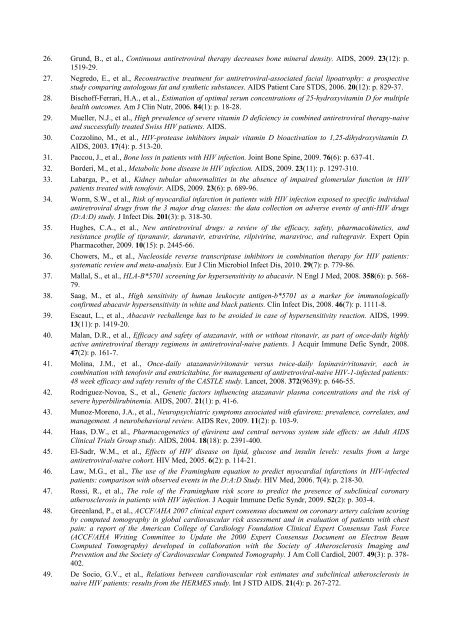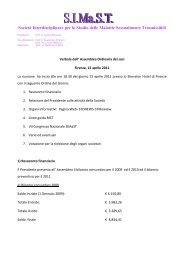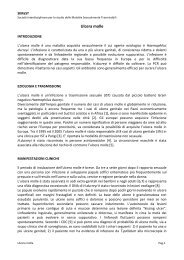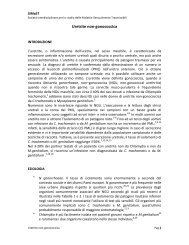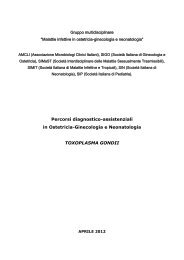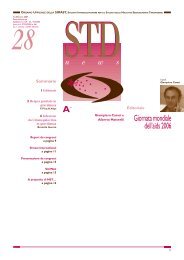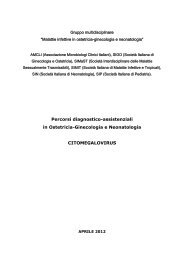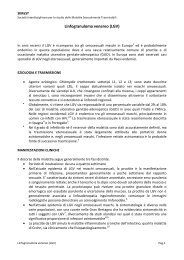26. Grund, B., et al., Continuous antiretroviral therapy decreases bone mineral density. AIDS, 2009. 23(12): p.1519-29.27. Negredo, E., et al., Reconstructive treatment for antiretroviral-associated facial lipoatrophy: a prospectivestudy comparing autologous fat and synthetic substances. AIDS Patient Care STDS, 2006. 20(12): p. 829-37.28. Bischoff-Ferrari, H.A., et al., Estimation of optimal serum concentrations of 25-hydroxyvitamin D for multiplehealth outcomes. Am J Clin Nutr, 2006. 84(1): p. 18-28.29. Mueller, N.J., et al., High prevalence of severe vitamin D deficiency in combined antiretroviral therapy-naiveand successfully treated Swiss <strong>HIV</strong> patients. AIDS.30. Cozzolino, M., et al., <strong>HIV</strong>-protease inhibitors impair vitamin D bioactivation to 1,25-dihydroxyvitamin D.AIDS, 2003. 17(4): p. 513-20.31. Paccou, J., et al., Bone loss in patients with <strong>HIV</strong> infection. Joint Bone Spine, 2009. 76(6): p. 637-41.32. Borderi, M., et al., Metabolic bone disease in <strong>HIV</strong> infection. AIDS, 2009. 23(11): p. 1297-310.33. Labarga, P., et al., Kidney tubular abnormalities in the absence of impaired glomerular function in <strong>HIV</strong>patients treated with tenofovir. AIDS, 2009. 23(6): p. 689-96.34. Worm, S.W., et al., Risk of myocardial infarction in patients with <strong>HIV</strong> infection exposed to specific individualantiretroviral drugs from the 3 major drug classes: the data collection on adverse events of anti-<strong>HIV</strong> drugs(D:A:D) study. J Infect Dis. 201(3): p. 318-30.35. Hughes, C.A., et al., New antiretroviral drugs: a review of the efficacy, safety, pharmacokinetics, andresistance profile of tipranavir, darunavir, etravirine, rilpivirine, maraviroc, and raltegravir. Expert OpinPharmacother, 2009. 10(15): p. 2445-66.36. Chowers, M., et al., Nucleoside reverse transcriptase inhibitors in combination therapy for <strong>HIV</strong> patients:systematic review and meta-analysis. Eur J Clin Microbiol Infect Dis, 2010. 29(7): p. 779-86.37. Mallal, S., et al., HLA-B*5701 screening for hypersensitivity to abacavir. N Engl J Med, 2008. 358(6): p. 568-79.38. Saag, M., et al., High sensitivity of human leukocyte antigen-b*5701 as a marker for immunologicallyconfirmed abacavir hypersensitivity in white and black patients. Clin Infect Dis, 2008. 46(7): p. 1111-8.39. Escaut, L., et al., Abacavir rechallenge has to be avoided in case of hypersensitivity reaction. AIDS, 1999.13(11): p. 1419-20.40. Malan, D.R., et al., Efficacy and safety of atazanavir, with or without ritonavir, as part of once-daily highlyactive antiretroviral therapy regimens in antiretroviral-naive patients. J Acquir Immune Defic Syndr, 2008.47(2): p. 161-7.41. Molina, J.M., et al., Once-daily atazanavir/ritonavir versus twice-daily lopinavir/ritonavir, each incombination with tenofovir and emtricitabine, for management of antiretroviral-naive <strong>HIV</strong>-1-infected patients:48 week efficacy and safety results of the CASTLE study. Lancet, 2008. 372(9639): p. 646-55.42. Rodriguez-Novoa, S., et al., Genetic factors influencing atazanavir plasma concentrations and the risk ofsevere hyperbilirubinemia. AIDS, 2007. 21(1): p. 41-6.43. Munoz-Moreno, J.A., et al., Neuropsychiatric symptoms associated with efavirenz: prevalence, correlates, andmanagement. A neurobehavioral review. AIDS Rev, 2009. 11(2): p. 103-9.44. Haas, D.W., et al., Pharmacogenetics of efavirenz and central nervous system side effects: an Adult AIDSClinical Trials Group study. AIDS, 2004. 18(18): p. 2391-400.45. El-Sadr, W.M., et al., Effects of <strong>HIV</strong> disease on lipid, glucose and insulin levels: results from a largeantiretroviral-naive cohort. <strong>HIV</strong> Med, 2005. 6(2): p. 114-21.46. Law, M.G., et al., The use of the Framingham equation to predict myocardial infarctions in <strong>HIV</strong>-infectedpatients: comparison with observed events in the D:A:D Study. <strong>HIV</strong> Med, 2006. 7(4): p. 218-30.47. Rossi, R., et al., The role of the Framingham risk score to predict the presence of subclinical coronaryatherosclerosis in patients with <strong>HIV</strong> infection. J Acquir Immune Defic Syndr, 2009. 52(2): p. 303-4.48. Greenland, P., et al., ACCF/AHA 2007 clinical expert consensus document on coronary artery calcium scoringby computed tomography in global cardiovascular risk assessment and in evaluation of patients with chestpain: a report of the American College of Cardiology Foundation Clinical Expert Consensus Task Force(ACCF/AHA Writing Committee to Update the 2000 Expert Consensus Document on Electron BeamComputed Tomography) developed in collaboration with the Society of Atherosclerosis Imaging andPrevention and the Society of Cardiovascular Computed Tomography. J Am Coll Cardiol, 2007. 49(3): p. 378-402.49. De Socio, G.V., et al., Relations between cardiovascular risk estimates and subclinical atherosclerosis innaive <strong>HIV</strong> patients: results from the HERMES study. Int J STD AIDS. 21(4): p. 267-272.
50. Calmy, A., et al., <strong>HIV</strong> increases markers of cardiovascular risk: results from a randomized, treatmentinterruption trial. AIDS, 2009. 23(8): p. 929-39.51. Moyle, G.J., et al., A randomized comparative trial of tenofovir DF or abacavir as replacement for athymidine analogue in persons with lipoatrophy. AIDS, 2006. 20(16): p. 2043-50.52. Martin, A., et al., Reversibility of lipoatrophy in <strong>HIV</strong>-infected patients 2 years after switching from a thymidineanalogue to abacavir: the MITOX Extension Study. AIDS, 2004. 18(7): p. 1029-36.53. Mocroft, A., et al., Serious fatal and nonfatal non-AIDS-defining illnesses in Europe. J Acquir Immune DeficSyndr, 2010. 55(2): p. 262-70.54. Smith, C., et al., Factors associated with specific causes of death amongst <strong>HIV</strong>-positive individuals in theD:A:D Study. AIDS, 2010. 24(10): p. 1537-48.55. Currier, J.S., et al., Coronary heart disease in <strong>HIV</strong>-infected individuals. J Acquir Immune Defic Syndr, 2003.33(4): p. 506-12.56. Mary-Krause, M., et al., Increased risk of myocardial infarction with duration of protease inhibitor therapy in<strong>HIV</strong>-infected men. AIDS, 2003. 17(17): p. 2479-86.57. Triant, V.A., et al., Increased acute myocardial infarction rates and cardiovascular risk factors amongpatients with human immunodeficiency virus disease. J Clin Endocrinol Metab, 2007. 92(7): p. 2506-12.58. Durand, M., et al., Association between <strong>HIV</strong> infection, antiretroviral therapy, and risk of acute myocardialinfarction: a cohort and nested case-control study using Quebec's public health insurance database. J AcquirImmune Defic Syndr, 2011. 57(3): p. 245-53.59. Klein, D., et al., Do protease inhibitors increase the risk for coronary heart disease in patients with <strong>HIV</strong>-1infection? J Acquir Immune Defic Syndr, 2002. 30(5): p. 471-7.60. Rasmussen, L.D., et al., Risk of cerebrovascular events in persons with and without <strong>HIV</strong>: a Danish nationwidepopulation-based cohort study. AIDS, 2011. 25(13): p. 1637-46.61. Ovbiagele, B. and A. Nath, Increasing incidence of ischemic stroke in patients with <strong>HIV</strong> infection. Neurology,2011. 76(5): p. 444-50.62. Sabin, C.a.t.D.A.D.S.G., Associations between Markers of Immunosuppression and the Risk of CVD, in 19thConference on Retroviruses and Opportunistic Infections (CROI 2012), poster n.822. 2012: Seattle.63. Masia, M., et al., Endothelial function is impaired in <strong>HIV</strong>-infected patients with lipodystrophy. Antivir Ther.15(1): p. 101-10.64. Petoumenos, K., et al. Rates of Cardiovascular Disease following Smoking Cessation in Patients with <strong>HIV</strong>Infection: Results from the D:A:D Study. in 17th Conference on Retroviruses and Opportunist Infections.2010. San Francisco, CA, USA.65. Fitch, K.V., et al., Effects of a lifestyle modification program in <strong>HIV</strong>-infected patients with the metabolicsyndrome. AIDS, 2006. 20(14): p. 1843-50.66. Smith, K.Y., et al., Randomized, double-blind, placebo-matched, multicenter trial of abacavir/lamivudine ortenofovir/emtricitabine with lopinavir/ritonavir for initial <strong>HIV</strong> treatment. AIDS, 2009. 23(12): p. 1547-56.67. Madruga, J.V., et al., Efficacy and safety of darunavir-ritonavir compared with that of lopinavir-ritonavir at48 weeks in treatment-experienced, <strong>HIV</strong>-infected patients in TITAN: a randomised controlled phase III trial.Lancet, 2007. 370(9581): p. 49-58.68. Eron, J.J., et al., Switch to a raltegravir-based regimen versus continuation of a lopinavir-ritonavir-basedregimen in stable <strong>HIV</strong>-infected patients with suppressed viraemia (SWITCHMRK 1 and 2): two multicentre,double-blind, randomised controlled trials. Lancet, 2010. 375(9712): p. 396-407.69. Podzamczer D, S.V., Andrade-Villanueva J, Clotet B, Taylor S, Rockstroh J, et al., Comparison of lipid profilewith nevirapine versus atazanavir/ritonavir, both combined with tenofovir DF and emtricitabine (TDF/FTC),in treatment-naive <strong>HIV</strong>-1-infected patients: ARTEN study week 48 results., in 12th European AIDSConference/EACS. 2009: 11-14 November 2009 - Cologne, Germany.70. EACS Guidelines. 29/07/2011]; Available from: www.europeanaidsclinicalsociety.org/Guidelines.71. Monforte A, R.P., Ryom L, El-Sadr W, Dabis F, De Wit S, Worm S, Phillips A, Lundgren J, Sabin C, ATVcontainingART Is Not Associated with an Increased Risk of Cardio- or Cerebro-vascular Events in the D:A:DStudy, in 19th Conference on Retroviruses and Opportunistic Infections (CROI 2012), poster n.823. 2012:Seattle.72. Abgrall, S., et al., Switch from a first virologically effective protease inhibitor-containing regimen to a regimencontaining efavirenz, nevirapine or abacavir. AIDS, 2006. 20(16): p. 2099-106.73. Fichtenbaum, C.J. and J.G. Gerber, Interactions between antiretroviral drugs and drugs used for the therapy ofthe metabolic complications encountered during <strong>HIV</strong> infection. Clin Pharmacokinet, 2002. 41(14): p. 1195-211.
- Page 1 and 2:
Linee Guida Italiane sull’utilizz
- Page 3 and 4:
Questo tempestivo aggiornamento del
- Page 5 and 6:
controllati sono stati valutati in
- Page 7 and 8:
Linee Guida Italiane sull’utilizz
- Page 9 and 10:
PIANO DELL’OPERALinee Guida Itali
- Page 11 and 12:
VALUTAZIONE E PREPARAZIONE DEL PAZI
- Page 13 and 14:
- Esplicitare al paziente i possibi
- Page 15 and 16:
DIAGNOSTICA VIROLOGICALa diagnosi d
- Page 17 and 18:
ResistenzeLa prevalenza di farmaco-
- Page 19 and 20:
avvalersi, nella valutazione del te
- Page 21 and 22:
con tropismo X4) della metodica di
- Page 23 and 24:
specifiche (AS-RT-PCR) è stata cor
- Page 25 and 26:
grado di dare informazioni attendib
- Page 27 and 28:
QUANDO INIZIAREInfezione acutaSi st
- Page 29 and 30:
seguito alla terapia antiretroviral
- Page 31 and 32:
Nota: La valutazione della conta as
- Page 33 and 34:
- Pazienti con leucoencefalopatia m
- Page 35 and 36:
IntroduzioneCOME INIZIAREIl princip
- Page 37 and 38:
farmaci diversi da EFV, ATV/r e LPV
- Page 39 and 40:
Tabella 2 - Regimi alternativi per
- Page 41 and 42:
ddI+TDF (come backbone) Ridotta eff
- Page 43 and 44:
1. La riduzione del numero di farma
- Page 45 and 46:
controllo (stesso regime + 2NRTI) s
- Page 47 and 48:
opzione complessivamente vantaggios
- Page 49 and 50:
studio randomizzato e a disegno cro
- Page 51 and 52:
GESTIONE DEL FALLIMENTO TERAPEUTICO
- Page 53 and 54:
Gestione fallimento virologico con
- Page 55 and 56:
caratterizzati da una tollerabilit
- Page 57 and 58:
valutazione attenta nella composizi
- Page 59 and 60:
evidenziato un rischio significativ
- Page 61 and 62:
ADERENZA E QUALITÀ DELLA VITAADERE
- Page 63 and 64:
comportamenti salutari (potenziando
- Page 65 and 66:
Algoritimo gestionale per l’adere
- Page 67 and 68:
Per l’uso dei questionari per la
- Page 69 and 70:
- Parimenti ENF, non viene suggerit
- Page 71 and 72:
Le benzodiazepine come alprazolam,
- Page 73 and 74:
glucoronosyl-transferase 1A1 (UGT1A
- Page 75 and 76:
SEZIONE 2Patologie associate all’
- Page 77 and 78:
MALATTIA CARDIOVASCOLARE, EPATICA,
- Page 79 and 80:
Screening per patologie non infetti
- Page 81 and 82:
Dosaggio Vitamina D + + -Annuale, p
- Page 83 and 84:
assenza di screening, il farmaco no
- Page 85 and 86:
INTERVENTISmettere di fumarePRINCIP
- Page 87 and 88:
MALATTIA CARDIOVASCOLARELe malattie
- Page 89 and 90:
- Terapie complementari:1. Le terap
- Page 91 and 92:
3. L’esposizione cumulativa a ini
- Page 93 and 94:
- Switch di terapia antiretrovirale
- Page 95 and 96:
LIPODISTROFIALa lipodistrofia ha un
- Page 97 and 98:
Il fenotipo lipodistrofico di tipo
- Page 99 and 100:
2. In caso di Sindrome di Fanconi
- Page 101 and 102:
DISFUNZIONI SESSUALIPer Disfunzione
- Page 103 and 104:
DEFICIT DI VITAMINA DL’insufficie
- Page 105 and 106:
Di seguito alcune abbreviazioni uti
- Page 107 and 108:
- Depressione;- Disturbi d’ansia;
- Page 109 and 110:
Figura 1- Algoritmo per la diagnosi
- Page 111 and 112:
approccio veloce e semplice, potend
- Page 113 and 114:
indipendentemente dalla presenza di
- Page 115 and 116:
I benefici di cART in pazienti con
- Page 117 and 118:
TUMORILa terapia dei tumori associa
- Page 119 and 120:
SARCOMA DI KAPOSI (SK)La scelta del
- Page 121 and 122:
chirurgica o una terapia ablativa,
- Page 123 and 124:
SEZIONE 2bPatologie infettive assoc
- Page 125 and 126:
malattia da HIV instabile (indicati
- Page 127 and 128:
significative interferenze farmacol
- Page 129 and 130:
Tabella 1 - Classificazione della f
- Page 131 and 132:
Figura 1 - Criteri di gestione dell
- Page 133 and 134:
antitubercolare, entrambi hanno dim
- Page 135 and 136:
farmacologico, sono preferibili, qu
- Page 137 and 138:
Persone con infezione da HIV ed ITL
- Page 139 and 140:
INFEZIONI OPPORTUNISTICHENonostante
- Page 141 and 142:
è subottimale, può essere presa i
- Page 143 and 144:
Dal momento che l’aderenza alla p
- Page 145 and 146:
PAZIENTE ANZIANOI pazienti anziani
- Page 147 and 148:
Tabella 1 - Caratteristiche del paz
- Page 149 and 150:
zidovudina [14]. Per quanto riguard
- Page 151 and 152:
ispetto alla popolazione sana, si a
- Page 153 and 154:
- Si raccomanda l’individuazione
- Page 155 and 156:
Tossicità, comorbositàIl rischio
- Page 157 and 158:
PAZIENTE PEDIATRICOQuesto documento
- Page 159 and 160:
- La combinazione ABC/3TC ha dimost
- Page 161 and 162:
L’aderenza alla terapia antiretro
- Page 163 and 164:
Tabella 4 - Farmaci antiretrovirali
- Page 165 and 166:
Viracept® compresserivestite 250 m
- Page 167 and 168:
TOSSICODIPENDENZA E/O ALCOL-DIPENDE
- Page 169 and 170:
Oppiacei naturali e HAARTL’eroina
- Page 171 and 172:
LSD ? ? ? ? ? ? ? ? ■ ? ?Ketamina
- Page 173 and 174:
fosamprenavir■ ▲ verosimilmente
- Page 175 and 176:
nuovo sistema nazionale di rilevame
- Page 177 and 178:
GRAVIDANZAQuesto documento esamina
- Page 179 and 180:
Terapia antiretrovirale in donne ch
- Page 181 and 182:
trattamento dell’infezione da HBV
- Page 183 and 184:
EtravirinaRilpivirinaunivoche. In d
- Page 185 and 186:
TRAPIANTISelezione dei pazienti con
- Page 187 and 188:
Riferimento del paziente al centro
- Page 189 and 190:
trapiantologico i pazienti competon
- Page 191 and 192:
Più recentemente lo studio clinico
- Page 193 and 194:
Le evidenze disponibili, incluse qu
- Page 195 and 196:
come appropriato; è consigliabile
- Page 197 and 198:
Tabella 2 - Rischio di sieroconvers
- Page 199 and 200:
Vaccinazioni nell’adultoPNEUMOCOC
- Page 201 and 202:
INFLUENZA - Durata e severità clin
- Page 203 and 204:
quadrivalente somministrate a dista
- Page 205 and 206:
PCV: vaccino antipneumococcico coni
- Page 207 and 208:
quali anche l’immunodepressione d
- Page 209 and 210:
Tabella 1 - Principali vaccinazioni
- Page 211 and 212:
Linee Guida Italiane sull’utilizz
- Page 213 and 214:
INTERNATIONAL HIV-DEMENTIA SCALE (I
- Page 215 and 216:
MINI MENTAL STATE EXAMINATION (MMSE
- Page 217 and 218:
Note per la somministrazione del te
- Page 219 and 220:
GAD-7Nelle ultime 2 settimane, con
- Page 221 and 222:
Attenzione/Working MemorySubtest Me
- Page 223 and 224:
QUESTIONARIO IADL (AUTONOMIA NELLE
- Page 225 and 226:
APPROFONDIMENTO 2 - CENTRI TRAPIANT
- Page 227 and 228:
Linee Guida Italiane sull’utilizz
- Page 229 and 230:
Toxoplasmosi cerebraleLa terapia di
- Page 231 and 232:
Tabella 8 - Terapia delle infezioni
- Page 233 and 234:
paragonabile assorbimento. In caso
- Page 235 and 236:
Altre infezioni erpeticheLe indicaz
- Page 237 and 238:
HIV E GRAVIDANZAIntroduzioneIl modi
- Page 239 and 240:
sono presenti informazioni e se è
- Page 241 and 242:
stabile della carica virale nelle d
- Page 243 and 244:
Nella valutazione ostetrico-ginecol
- Page 245 and 246:
Analoghi Non Nucleosidici (NNRTI)a
- Page 247 and 248:
l’esposizione agli antiretroviral
- Page 249 and 250:
quanto possibile e compatibilmente
- Page 251 and 252: MONITORAGGIO EFFICACIA DIART/TOSSIC
- Page 253 and 254: Tabella 1 - Criteri per l’inizio
- Page 255 and 256: affaticamento, disturbi del sonno,
- Page 257 and 258: Scelta del nuovo regime antiretrovi
- Page 259 and 260: Sindrome lipodistroficaQuesto termi
- Page 261 and 262: Tabella 6 - Farmaci antiretrovirali
- Page 263 and 264: BID.Dosaggi EMA:Bambini > 6 anni:>
- Page 265 and 266: primo anno dall’inizio della tera
- Page 267 and 268: anni)• Considerare l’uso di ins
- Page 269 and 270: VALUTAZIONE E PREPARAZIONE DEL PAZI
- Page 271 and 272: 17. Charpentier C, Landman R, Laou
- Page 273 and 274: 50. Vandekerckhove L, Wensing A, Ka
- Page 275 and 276: 86. Sarmati L, Andreoni C, Nicastri
- Page 277 and 278: QUANDO INIZIAREInfezione acuta1. Sc
- Page 279 and 280: Lewden C,,Bouteloup V, De Wit S, Sa
- Page 281 and 282: COME INIZIARE1. Gallant JE, DeJesus
- Page 283 and 284: infected patients: pooled results f
- Page 285 and 286: Lopinavir-ritonavir monotherapy ver
- Page 287 and 288: patients from twice-daily fixed-dos
- Page 289 and 290: 4. Garrido C, Villacian J, Zahonero
- Page 291 and 292: 20. Hightower KE, Wang R, Deanda F,
- Page 293 and 294: ADERENZA E QUALITÀ DELLA VITAAdere
- Page 295 and 296: 41. Trotta MP, Ammassari A, Cozzi-L
- Page 297 and 298: 25. Lorenz KA, Cunningham WE, Sprit
- Page 299 and 300: 19. Jaworsky D, Thompson C, Yudin M
- Page 301: PATOLOGIE NON INFETTIVE ASSOCIATE A
- Page 305 and 306: 102. Leyes, P., E. Martinez, and T.
- Page 307 and 308: DISTURBI NEUROCOGNITIVI E/O PSICHIA
- Page 309 and 310: 39. Price RW, Spudich S. Antiretrov
- Page 311 and 312: 79. Sacktor N, McDermott MP, Marder
- Page 313 and 314: 20. Achenbach CJ,Cole S,Kitahata M,
- Page 315 and 316: 62. Mounier N, Spina M, Gabarre J,
- Page 317 and 318: PATOLOGIE INFETTIVE ASSOCIATE ALL
- Page 319 and 320: of the European Association for the
- Page 321 and 322: 23. Lopez-Cortes LF, Ruiz-Valderas
- Page 323 and 324: PAZIENTE ANZIANO1. Notiziario ISS-
- Page 325 and 326: 40. Hasse B. Ledergerber B. Furrer
- Page 327 and 328: 21. Galli M, Veglia F, Angarano G,
- Page 329 and 330: 63. Patel R, Kassaye S, Gore-Felton
- Page 331 and 332: 21. Buchacz K et al. Syphilis incre
- Page 333 and 334: PAZIENTE PEDIATRICO1. HIV Paediatri
- Page 335 and 336: TOSSICODIPENDENZA E/O ALCOL-DIPENDE
- Page 337 and 338: 47. Bart PA, Rizzardi PG, Gallant S
- Page 339 and 340: 18. Edwards S., Tenant-Flowers M, B
- Page 341 and 342: TRAPIANTI1. E. A. Blumberg, P. Stoc
- Page 343 and 344: in men. Cochrane Database Syst Rev
- Page 345 and 346: 64. Barham L, Lewis D, Latimer N. O
- Page 347 and 348: 24. Tedaldi EM, Baker RK, Moorman A
- Page 349 and 350: 7. Kaplan JE, et al. Guidelines for
- Page 351 and 352: BIBLIOGRAFIA DI RIFERIMENTO INFEZIO
- Page 353 and 354:
35. Molina JM,Chastang C, Coguel J
- Page 355 and 356:
BIBLIOGRAFIA DI RIFERIMENTO/NOTA HI
- Page 357 and 358:
34. Tuomala RE, Shapiro DE, Mofenso
- Page 359 and 360:
BIBLIOGRAFIA DI RIFERIMENTO PAZIENT
- Page 361 and 362:
37. Sulkowski MS, Thomas DL, Mehta
- Page 363 and 364:
72. Wiener L, Riekert K, Ryder C, W
- Page 365 and 366:
Finarelli Alba Carola Nessuna Nessu


